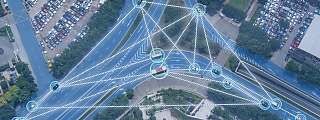





A geofence can be defined as a virtual fence around a delimited geographical location. Geofencing is the use of this digital fence to trigger an action when entering or leaving this perimeter.
Geofencing is used by companies in multiple industries. Have you ever seen ads regarding something specific to your neighborhood? Or, perhaps, the weather in your city? Well, these are a few examples of how modern geofencing is used in the marketing business.
However, geofencing also has extremely valuable usages for fleet managers.
What is geofencing in fleet management?
In fleet management, geofencing is a GPS-based feature that allows you to digitally draw geofences in key locations to trigger a pre-defined action. These key locations can be your main office, secondary offices, customer’s locations, secure areas or even cities, to name just a few.
How can geofencing improve your fleet efficiency?
As mentioned above, a geofence can be drawn in key places like your main parking lot. With GPS-based geofencing, you can monitor fleets whenever they enter or exit this pre-defined area.
Geofencing can help you to easily keep track of important events, like entering a country, with real-time notifications, which are also referred to as Geofence Alerts. These alerts can also ensure you get immediate notification if a serious incident of some kind occurs. For example, if one of your vehicles exits an area that it is not supposed to leave or at a time that was not planned, you get notified in real-time and can quickly act on the information.
The benefits of geofencing in fleet management
Geofencing is highly valuable for organisations with mobile workforces and fleets, as it gives you greater visibility over your operation and productivity. This positively impacts your planning and helps you improve resource allocation.
Geofencing also helps you to:
- Simplify communications. Receive notifications when fleets reach a certain location or checkpoint.
- Analyse operations. Keep track of location visits, average time spent with customer and detention details.
- Reduce detention times. You can improve detention times thanks to automated alerts that can be sent to facilities and receivers to notify them the vehicle is about to reach them.
When integrated with telematics software like Webfleet, geofencing can give you full visibility over your operations, increasing safety and transparency in your organisation. If you want to learn more about geofencing, get in contact with one of our experts today.

How secure and safe are your trucks on the road?

Safety is an integral part of any successful transport company.
Your consent is required
In this section, external content is being embedded from .
To display the content, your consent is required for the following cookie categories:
- Targeted Advertising
- Analytics & Personalization
- Essential
For further details, please refer to our privacy policy. If you are interested in how ###vendor_name### processes your data, please visit their privacy policy.














